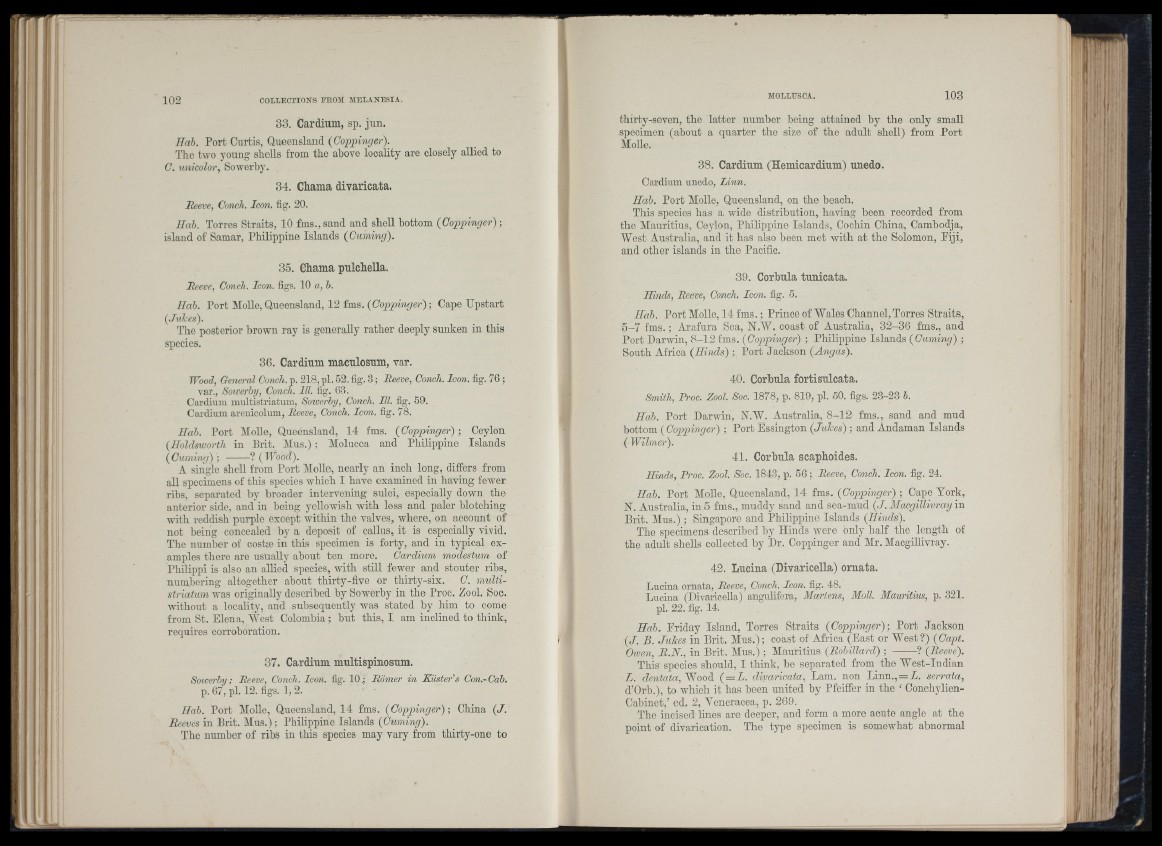
102
33. Cardium, sp. jun.
Hah. Port Curtis, Queensland (Coppinger).
The two young shells from the above locality are closely allied to
C. unicolor, Sowerhy.
34. Chama divaricata.
Reeve, Conch. Icon. fig. 20.
Hah. Torres Straits, 10 fms., sand and shell bottom (Coppinger) ;
island of Samar, Philippine Islands (Cuming).
35. Chama pulchella.
Reeve, Conch. Icon. figs. 10 a, h.
Hah. Port Molle, Queensland, 12 fms. (Coppinger); Cape Upstart
(Jukes).
The posterior brown ray is generally rather deeply sunken in this
species.
36. Cardium maculosum, var.
Wood, General Conch, p. 218, pi. 52. fig. 3 ; Reeve, Conch. Icon. fig. 76 ;
var., Sowerhy, Conch. III. fig. 63.
Cardium multistriatum, Soiverhy, Conch. III. fig. 59.
Cardium arenicolum. Reeve, Conch. Icon. fig. 78.
Hah. Port MoUe, Queensland, 14 fms. (Coppinger); Ceylon
(Holdsworth in Brit. Mus.) ; Molucca and Philippine Islands
(Cuming) ; ------ 1 (Wood).
A single shell from Port Molle, nearly an inch long, differs from
all specimens of this species which I have examined in having fewer
ribs, separated by broader intervening sulci, especially down the
anterior side, and in being yellowish with less and paler blotching
with reddish purple except within the valves, where, on account of
not being concealed by a deposit of callus, it is especially vivid.
The number of costæ in this specimen is forty, and in typical examples
there are usually about ten more. Cardium modestum of
Philippi is also an allied species, with still fewer and stouter ribs,
numbering altogether about thirty-five or thirty-six. C. multistriatum
was originally described by Sowerby in the Proc. Zool. Soc.
without a locality, and subsequently was stated by him to come
from St. Elena, AVest Colombia ; hut this, I am inclined to think,
requires corroboration.
37. Cardium multispiuosum.
Soiverhy ; Reeve, Conch. Icon. fig. 10,; Romer in Kiister’s Con.-Cab.
p. 67, pi. 12. figs. 1, 2.
Hab. Port Molle, Queensland, 14 fms. (Coppinger); China (J.
Beeves in Brit. Mus.) ; Philippine Islands (Cuming).
The number of ribs in this species may vary from thirty-one to
thirty-seven, the latter number being attained by the only smaU
specimen (about a quarter tho size of the adult shell) from Port
Molle.
38. Cardium (Hemicardium) uuedo.
Cardium unedo, Linn.
Hah. Port Molle, Queensland, on the beach.
This species has a wide distribution, having been recorded from
the Mauritius, Ceylon, Philippine Islands, Cochin China, Cambodja,
AVest Australia, and it has also been met with at the Solomon, Eiji,
and other islands in the Pacific.
39. Corbula tuuicata.
Hinds, Reeve, Conch. Leon. fig. 5.
Hab. Port Molle, 14 fms.; Prince of AVales Channel, Torres Straits,
5 -7 fm s .; Arafura Sea, N.AV. coast of Australia, 32-36 fms., and
Port Darwin, 8-12 fms. (Coppinger) ; Philippine Islands (Cuming) ;
South Africa (Hinds) ; Port Jackson (Angas).
40. Corbula fortisulcata.
Smith, Proc. Zool. Soc. 1878, p. 819, pi. 50. figs. 23-23 b.
Hab. Port Darwin, N.AV. Australia, 8 -12 fms., sand and mud
hottom (Coppinger) ; Port Essington (Jukes); and Andaman Islands
(Wilmer).
41. Corbula scaphoides.
Hinds, Proc. Zool. Soc. 1843, p. 56; Reeve, Conch. Icon. fig. 24.
Hah. Port Molle, Queensland, 14 fms. (Coppinger) ; Cape York,
N. Australia, in 5 fms., muddy sand and sea-miid (J. Macgillivray in
Brit. Mus.) ; Singapore and Philippine Islands (Hinds).
The specimens described by Hinds were only half the length of
the adult shells collected by Dr. Coppinger and Mr. Macgillivray.
42. Luciua (Divaricella) oruata.
Lucina ornata, Reeve, Conch. Icon. fig. 48.
Lucina (Divaricella) angulifera. Martens, Moll. Mauritius, p. 321.
pi. 22. fig. 14.
Hab. Eriday Island, Torres Straits (Coppinger); Port Jackson
(J. B. Jukes in Brit. Mus.); coast of Africa (East or AVest^?) (Capt.
Owen, R.N., in Brit. Mus.) ; Mauritius (Robillard) ; ------ ? (Reeve).
This species should, I think, he separated from the AVest-Indian
L. dentata, AVood (= L . divaricata, Lam. non Linn., = A. serrata,
d’Orh.), to which it has been united by Pfeiffer in the ‘ Conchylien-
Cabinet,’ ed. 2, Veneracea, p. 269.
The incised lines are deeper, and form a more acute angle at the
point of divarication. The type specimen is somewhat abnormal
I'M